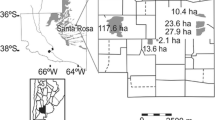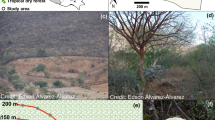Abstract
Variation in nest predation levels associated with rainforest fragmentation (edge effects) was assessed in Australia's Wet Tropics bioregion. Artificial nests were placed in the forest understorey at seven edge sites where continuous forest adjoined pasture, seven interiors (about 1 km from the edge), and six linear riparian forest remnants (50–100 m wide) that were connected to continuous forest. Four nest types were also compared, representing different combinations of two factors; height (ground, shrub) and shape (open, domed). At each site, four nests of each type, containing one quail egg and two model plasticine eggs, were interspersed about 15 m apart within a 160 m transect during September–October 2001. Predators were identified from marks on the plasticine eggs. The overall depredation rate was 66.5% of 320 nests' contents damaged over a three-day period. Large rodents, especially the rat Uromys caudimaculatus, and birds, especially the spotted catbird Ailuroedus melanotis, were the main predators. Mammals comprised 56.5% and birds 31.0% of predators, with 12.5% of unknown identity. The depredation rate did not vary among site-types, or between open and domed nests, and there were no statistically significant interactions. Nest height strongly affected depredation rates by particular types of predator; depredation rates by mammals were highest at ground nests, whereas attacks by birds were most frequent at shrub nests. These effects counterbalanced so that overall there was little net effect of nest height. Mammals accounted for 78.4% of depredated ground nests and birds for at least 47.4% of shrub nests (and possibly up to 70.1%). The main predators were species characteristic of rainforest, rather than habitat generalists, open-country or edge specialists. For birds that nest in the tropical rainforest understorey of the study region, it is unlikely that edges and linear remnants presently function as ecological population sinks due to mortality associated with increased nest predation.
Similar content being viewed by others
References
H. Andren (1995) Effects of landscape composition on predation rates at habitat edges L. Hansson L. Fahrig G. Merriam (Eds) Mosaic Landscapes and Ecological Processes Chapman & Hall London 225–255
N. Arango-Velez G.H. Kattan (1997) ArticleTitleEffects of forest fragmentation on experimental nest predation in Andean Cloud forest Biol. Conserv. 81 137–143 Occurrence Handle10.1016/S0006-3207(96)00138-3
M. Blakers S.J.J.F. Davies P.N. Reilly (1984) The Atlas of Australian Birds Melbourne University Press Melbourne, Australia
A. Carlson G. Hartman (2001) ArticleTitleTropical forest fragmentation and nest predation: an experimental study an Eastern Arc montane forestTanzania Biodiv. Conserv. 10 1107–1185
F.H.J. Crome J. Isaacs L. Moore (1994) ArticleTitleThe utility to birds and mammals of remnant riparian vegetation and associated windbreaks in the tropical Queensland uplands Pac. Conserv. Biol. 1 328–343
L.M. Eriksson V. Areskoug D.A. Meritt SuffixJr. (200l) ArticleTitleNest predation at the edge: an experimental study contrasting two types of edges in the dry Chaco Paraguay Ecography 24 742–750 Occurrence Handle10.1034/j.1600-0587.2001.240612.x
K. Frawley (1991) Past rainforest management in Queensland G. Werren P. Kershaw (Eds) The Rainforest Legacy. Volume 3 – Rainforest History, Dynamics and Management Australian Government Publishing Service Canberra, Australia 85–106
C.B. Frith D.W. Frith (2001) ArticleTitleNesting biology of the spotted catbirdAiluroedus melanotisa monogamous bower bird (Ptilonorhynchidae), in Australian Wet Tropics upland rainforests Aust. J. Zool. 49 279–310 Occurrence Handle10.1071/ZO00061
C.B. Frith D.W. Frith (2004) The Bowerbirds Oxford University Press Oxford, UK
J.P. Gibbs (1991) ArticleTitleAvian nest predation in tropical wet forest: an experimental study Oikos 60 155–161
H.B. Gill (1970) ArticleTitleBirds of Innisfail and hinterland Emu 70 105–116
M. Giuliano G. Bogliani (1999) ArticleTitleEffect of nest features and surrounding landscape on predation rates of artificial nests Bird Study 46 184–194
M. Goosem (1997) The effects of roads, highways, and powerline clearings on movement and mortality of rainforest vertebrates W.F. Laurance R.O. Bierregaard (Eds) Tropical Forest Remnants. Managementand Conservation of Fragmented Communities University of Chicago Press Chicago, Illinois 241–255
A.W. Graham M.S. Hopkins J. Maggs (1996) 1:50 000 Vegetation Map of Complex Mesophyll Vine Forest (Type 1b) from the Atherton Tablelands Reference Areaand Explanatory Notes: Report to the Wet Tropics Management Authority CSIRO Division of Wildlife and Ecology Atherton, Australia
K.M. Henein G. Merriam (1990) ArticleTitleThe elements of connectivity where corridor quality is variable Landscape Ecol. 4 157–170 Occurrence Handle10.1007/BF00132858
J. Jokimaki E. Huhta (2000) ArticleTitleArtificial nest predation and abundance of birds along an urban gradient Condor 102 838–847
J. Kanowski C.P. Catterall G.W. Wardell-Johnson H. Proctor T. Reis (2003) ArticleTitleDevelopment of forest structure on cleared rainforest land in eastern Australia under different styles of reforestation Forest Ecol. Manage. 183 265–280 Occurrence Handle10.1016/S0378-1127(03)00109-9
A.J. Keyser G.E. Hill E.C. Soehren (1998) ArticleTitleEffects of forest fragment sizenest density, and proximity to edge on the risk of predation to ground-nesting passerine birds Conserv. Biol. 12 986–994 Occurrence Handle10.1046/j.1523-1739.1998.97177.x
D.C. Lahti (2001) ArticleTitleThe ‘edge effect on nest predation’ hypothesis after twenty years Biol. Conserv. 95 365–374 Occurrence Handle10.1016/S0006-3207(00)00222-6
D.C. Latta J.M. Wunderle E. Terranova M. Pagan (1995) ArticleTitleAn experimental study of nest predation in subtropical wet forest following hurricane disturbance Wilson Bull. 107 590–602
W.F. Laurance (1991) ArticleTitleEcological correlates of extinction proneness in Australian tropical rainforest mammals Conserv. Biol. 5 79–89 Occurrence Handle10.1111/j.1523-1739.1991.tb00390.x
W.F. Laurance (1997) ArticleTitleResponses of mammals to rainforest fragmentation in tropical Queensland: a review and synthesis Wildlife Res. 24 603–612 Occurrence Handle10.1071/WR96039
W.F. Laurance J. Garesche C.W. Payne (1993) ArticleTitleAvian nest predation in modified and natural habitats in tropical Queensland: an experimental study Wildlife Res. 20 711–723 Occurrence Handle10.1071/WR9930711
W.F. Laurance J.D. Grant (1994) ArticleTitlePhotographic identification of ground-nest predators in Australian tropical rainforest Wildlife Res. 21 241–248 Occurrence Handle10.1071/WR9940241
B.A. Loiselle W.G. Hoppes (1983) ArticleTitleNest predation in insular and mainland lowland rainforest in Panama Condor 55 93–95
R.E. Major F.J. Christie G. Gowing T.T. Ivison (1999) ArticleTitleElevated rates of predation on artificial nests in linear strips of habitat J. Field Ornithol. 70 351–364
R.E. Major G. Gowing C.E. Kendal (1996) ArticleTitleNest predation in Australian urban environments and the role of the pied currawong, Strepera graculina Aust. J. Ecol. 21 399–409
R.E. Major C.E. Kendal (1996) ArticleTitleThe contribution of artificial nest experiments to understanding avian reproductive success: a review of methods and conclusions Ibis 138 298–307
D.T. Malcome B.K.A. Nagei I.S. Webb I.G. Sinclair (1996) Remnant Vegetation of the Atherton and Evelyn Tablelands (Scale 1:100 000, Map Ref. No. 96-MISC-M-j1069) Queensland Department of Primary Industries Mareeba
T.E. Martin (1995) ArticleTitleAvian life history evolution in relation to nest sites, nest predation and food Ecol. Monogr. 65 101–127
C. Murcia (1995) ArticleTitleEdge effects in fragmented forests: implications for conservation (a review) Trends Ecol. Evol. 10 58–62 Occurrence Handle10.1016/S0169-5347(00)88977-6
N. Nour E. Matthysen A.A. Dhondt (1993) ArticleTitleArtificial nest predation and habitat fragmentation: different trends in bird and mammal predators Ecography 16 111–116
P.W.C. Paton (1994) ArticleTitleThe effects of edge on avian nest success: how strong is the evidence? Conserv. Biol. 8 17–26 Occurrence Handle10.1046/j.1523-1739.1994.08010017.x
S. Piper C.P. Catterall M. Olsen (2002) ArticleTitleDoes adjacent land use affect predation of artificial shrub nests near eucalypt forest Wildlife Res. 29 127–133 Occurrence Handle10.1071/WR01072
G.P. Quinn M.J. Keogh (2002) Experimental Design and Data Analysis for Biologists Cambridge University Press CambridgeUK
S.A. Rangen R.G. Clark K.A. Hobson (2000) ArticleTitleVisual and olfactory attributes of artificial nests Auk 117 136–146
R.E. Ricklefs (1969) ArticleTitleAn analysis of nesting mortality in birds Smithsonian Contrib. Zool. 9 1–48
D.K. Rosenberg B.R. Noon E.C. Meslow (1997) ArticleTitleBiological corridors: formfunction and efficacy Bioscience 47 677–688
D.A. Saunders R.J. Hobbs C.R. Margules (1991) ArticleTitleBiological consequences of ecosystem fragmentation Conserv. Biol. 5 1–15 Occurrence Handle10.1111/j.1523-1739.1991.tb00384.x
K.E. Sieving M.F. Willson (1998) ArticleTitleNest predation and avian species diversity in northwestern forest understory Ecology 79 2391–2402
D.A. Simberloff J.A. Farr J. Cox D.W. Mehlman (1992) ArticleTitleMovement corridors: conservation bargains or poor investments? Conserv. Biol. 6 493–504 Occurrence Handle10.1046/j.1523-1739.1992.06040493.x
B. Soderstrom (1999) ArticleTitleArtificial nest predation rates in tropical and temperate forests: a review of the effects of edge and nest site Ecography 22 455–463
B. Soderstrom T. Part J. Ryden (1998) ArticleTitleDifferent nest predator faunas and nest predation risk on ground and shrub nests at forest ecotones: an experiment and a review Oecologia 117 108–118 Occurrence Handle10.1007/s004420050638
InstitutionalAuthorNameSPSS (1990) Base System Users Guide SPSS Inc. Chicago, Illinois
L.N. Taylor H.A. Ford (1998) ArticleTitlePredation of artificial nests in a fragmented landscape on the New England Tablelands of New South Wales Wildlife Res. 25 587–594 Occurrence Handle10.1071/WR98034
J.L. Telleria M. Diaz (1995) ArticleTitleAvian nest predation in a large natural gap of the Amazonian rainforest J. Field Ornithol. 66 343–351
J.L. Tewksbury S.J. Heji T.E. Martin (1998) ArticleTitleBreeding productivity does not decline with increasing fragmentation in a western landscape Ecology 79 2890–2903
G.J. Tracey (1982) The Vegetation of the Humid Tropical Region of North Queensland CSIRO Melbourne, Australia
D.S. Wilcove (1985) ArticleTitleNest predation in forest tracts and the decline of migratory songbirds Ecology 66 1211–1214
S.E. Williams R.G. Pearson P.J. Walsh (1996) ArticleTitleDistribution and biodiversity of terrestrial vertebrates of Australia's Wet Tropics: a review of current knowledge Pac. Conserv. Biol. 2 327–362
T.C.M. Wong N.S. Sodhi I.M. Turner (1998) ArticleTitleArtificial nests and seed predation experiments in tropical lowland rainforest remnants of Singapore Biol. Conserv. 85 87–104 Occurrence Handle10.1016/S0006-3207(97)00145-6
Author information
Authors and Affiliations
Corresponding author
Rights and permissions
About this article
Cite this article
Hausmann, F., Catterall, C. & Piper, S. Effects of Edge Habitat and Nest Characteristics on Depredation of Artificial Nests in Fragmented Australian Tropical Rainforest. Biodivers Conserv 14, 2331–2345 (2005). https://doi.org/10.1007/s10531-004-1667-y
Received:
Accepted:
Issue Date:
DOI: https://doi.org/10.1007/s10531-004-1667-y




